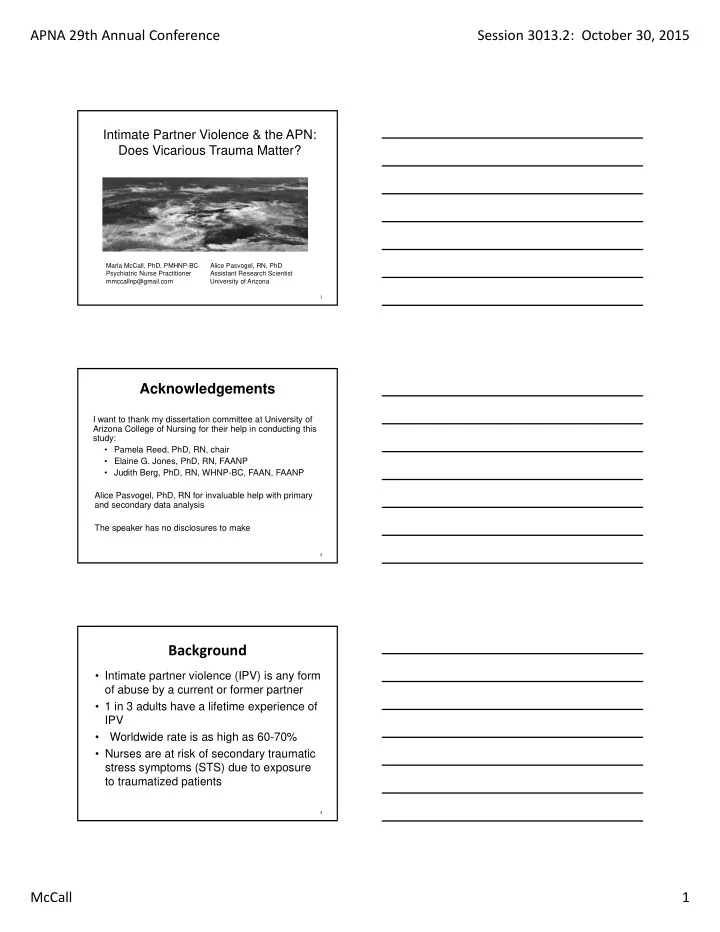

APNA 29th Annual Conference Session 3013.2: October 30, 2015 Intimate Partner Violence & the APN: Does Vicarious Trauma Matter? Marla McCall, PhD, PMHNP-BC Alice Pasvogel, RN, PhD Psychiatric Nurse Practitioner Assistant Research Scientist mmccallnp@gmail.com University of Arizona 1 Acknowledgements I want to thank my dissertation committee at University of Arizona College of Nursing for their help in conducting this study: • Pamela Reed, PhD, RN, chair • Elaine G. Jones, PhD, RN, FAANP • Judith Berg, PhD, RN, WHNP-BC, FAAN, FAANP Alice Pasvogel, PhD, RN for invaluable help with primary and secondary data analysis The speaker has no disclosures to make 2 Background • Intimate partner violence (IPV) is any form of abuse by a current or former partner • 1 in 3 adults have a lifetime experience of IPV • Worldwide rate is as high as 60-70% • Nurses are at risk of secondary traumatic stress symptoms (STS) due to exposure to traumatized patients 3 McCall 1
APNA 29th Annual Conference Session 3013.2: October 30, 2015 Objectives • Describe factors that assist APNs in the appropriate management of intimate partner violence in the clinical setting • Identify factors that may negatively impact APNs ability to effectively manage IPV • Identify warning signs of Secondary Traumatic Stress in themselves 4 Why IPV? • IPV affects roughly one in three people • Many advanced practice nurses (APN) are the first health care provider victims will encounter when they might need help • Nurses may experience secondary traumatic stress (STS) or vicarious trauma(VT) as a result of work with victims 5 Study Design • National quantitative survey of APNs conducted in summer of 2014, n = 494 • Survey tools used o Modification of PREMIS o Secondary Traumatic Stress Scale o New General Self Efficacy Scale o Brief Resilience Scale 6 McCall 2
APNA 29th Annual Conference Session 3013.2: October 30, 2015 Results • Instruments had psychometric reliability • APNs averaged 5-10 hours of IPV education; up from 1-4 hours in only other national study in 1999 • APNs knowledge on IPV topics high-86% knowledge questions correct compared with 66% correct answers by physicians 7 Performance of APNs on IPV • 20% do not screen for IPV • 37% screen all new patients; unchanged • 90% of APNs did safety assessments • 94% helped develop safety plans • IPV disclosures reported in past 6 months- mean = 2.86 8 What Most Influenced Self- Efficacy to Treat IPV? • Estimated hours of IPV education • Years in full-time practice • APN role belief • Difficulties encountered by APNs include lack of privacy to screen, unclear work protocols, no place to chart, lack of resources; only half felt they had good overall support to treat IPV 9 McCall 3
APNA 29th Annual Conference Session 3013.2: October 30, 2015 Characteristics of Participants • Overall sample had above average resilience and self-efficacy • Close to 13% of APNs surveyed met clinical definition for STS or vicarious trauma (VT) o Mean years in practice 10, compared with 13 years without STS or VT (p = .047) o Age 27 - 71 years (Mean 49, SD 11 years) 10 Differences Between Groups with and without VT • Those with VT had lower scores (t-test) • Brief Resilience Test, p = .001 • New General Self-Efficacy test, p < .001 • Fewer years in FT practice, p = .047 • No differences between the groups on practice community type, location, past personal trauma, IPV education, educational degree, or age 11 Results Top variables in final model in order of weight 1. Current practices (resources included in this scale) 2. IPV education 3. Age in Years 4. Role Belief 5. Resilience 6. Vicarious Trauma-negative correlation with self- efficacy to treat 7. General Self-Efficacy 8. Workplace screening tools & protocols 9. IPV knowledge 12 McCall 4
APNA 29th Annual Conference Session 3013.2: October 30, 2015 Conclusions & Future Directions • Those with VT had • Less resilience and general self-efficacy • Less work experience as an APN (3 years) • Must work on interventions to support APNs to reduce the incidence of VT • Increase interventions to boost resilience 13 References • Beck, C. T. (2011). Secondary traumatic stress in nurses: a systematic review. Archives of Psychiatric Nursing, 25 (1), 1-10. doi: 10.1016/j.apnu.2010.05.005 • Bride, B.E., Robinson, M.R., Yegidis, B., & Figley, C.R. (2004). Development and validation of the Secondary Traumatic Stress Scale. Research on Social Work Practice, 14, 27-35. • Chen, G., Gully, S.M., & Eden, D. (2001). Validation of a new general self-efficacy scale. Organizational Research Methods, 4 (1), 62-83. • Hinderliter, D., Doughty, A. S., & Delaney, K. (2003). The effect of intimate partner violence education on nurse practitioners' feelings of competence and ability to screen patients. Journal of Nursing Education, 42 (10), 449-454. • Laschinger, H. K.S., Grau, A. L., Finegan, J., & Wilk, P. (2012). Predictors of new graduate nurses' workplace well-being: testing the job demands-resources model. Health Care Management Review, 37 (2), 175-186. doi: 10.1097/HMR.0b013e31822aa456 • McCall, M. (2014). Advanced practice Nurses’ Self-efficacy to Treat Intimate Partner Violence as Related to Professional, Workplace and Personal Factors (Doctoral Dissertation). http://arizona.openrepository.com/arizona/handle/10150/344226 Available after Dec. 8, 2015 • Short, L. M., Surprenant, Z. J., & Harris, J. M., Jr. (2006). A community-based trial of an online intimate partner violence CME program. American Journal of Preventive Medicine, 30 (2), 181-185. doi: 10.1016/j.amepre.2005.10.012 • Smith, B.W., Dalen, J., Wiggins, K., Tooley, E., Christopher, P., & Bernard, J. (2008). The brief resilience scale: Assessing the ability to bounce back. International Journal of Behavioral Medicine, 15 (3), 194-200. doi: 10.1080/10705500802222972 14 McCall 5
Recommend
More recommend